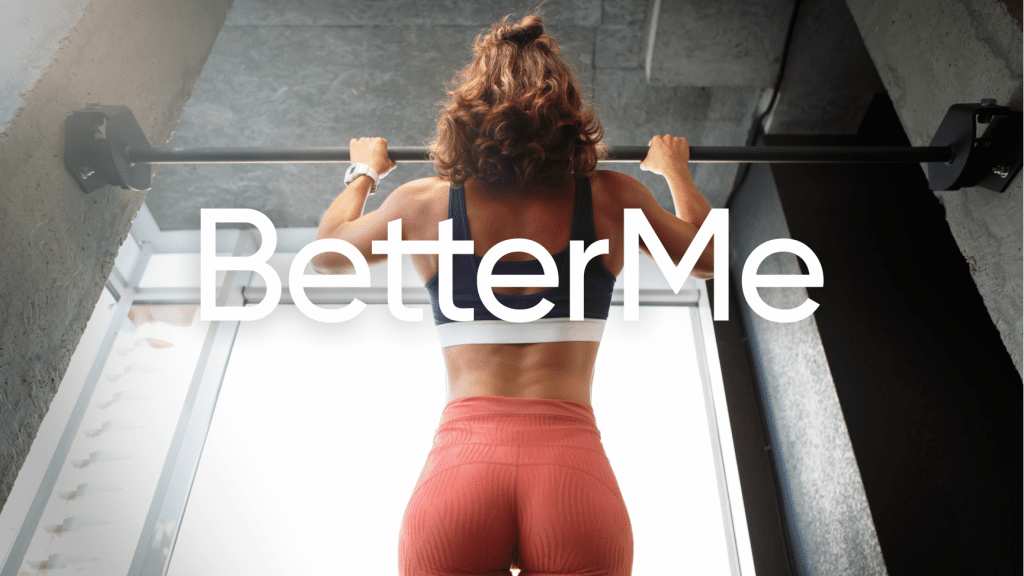Posture is the training of your body to stand, sit, lie down, and move in positions where the least amount of strain is placed, and in which you hold your body upright against gravity. Good posture involves supporting muscles and ligaments during activity or at rest (4). Technically, you can’t have a “perfect” posture— but you can have an “ideal” posture. To find your ideal posture, start by looking at yourself from the front, back, and side in a mirror. Then, imagine a line running from the middle of your earlobe through the center of your shoulder, elbow, wrist, and middle of your hand. This imaginary line should pass close to the center of your hip, knee, and ankle. Now that you know what ideal posture looks like, let’s take a closer look at the five most common types of posture and what you can do to improve each one.
Get your personalized
meal plan!
1. Kyphotic Posture
Kyphotic posture is characterized by rounded shoulders and an increased curve in the upper back. This type of posture is often seen in older adults, as the spine naturally begins to lose its normal curvature with age. Poor posture and muscle imbalances can also contribute to a rounded upper back (2).
If you have a kyphotic posture, there are a few things you can do to improve it.
First, focus on strengthening the muscles in your upper back and shoulders. Exercises like rows, pull-ups, and shoulder presses will help to correct muscle imbalances and improve posture. Then, make sure you’re not slouching when you sit or stand. Sit up tall with your shoulders back and down, and stand with your weight evenly distributed on both feet.
A shoulder posture brace can also help improve kyphotic posture by pulling the shoulders back and aligning the spine.
2. Lordotic Posture
Lordotic posture is characterized by an increased curve in the lower back. This type of posture is often seen in pregnant women and people who have weak abdominal muscles. Poor posture and muscle imbalances can also contribute to an increased curve in the lower back (3).
Some symptoms of lordotic posture include lower back pain, hip pain, and knee pain. If you have lordotic posture, there are a few things you can do to improve it.
First, focus on strengthening the muscles in your abdomen and back. Exercises like crunches, sit-ups, and Superman will help correct muscle imbalances and improve posture. Then, make sure you’re not slouching when you sit or stand. Sit up tall with your shoulders back and down, and stand with your weight evenly distributed on both feet.
Read More: Why And How You Should Use Yoga Blocks In Your Practice
3. Flat Back Posture
Your spine has a natural curve that forms an S-shape when viewed from the side. This curve helps to absorb shock and distribute weight evenly throughout the spine. When the spine loses its natural curve, it’s known as flat back posture.
Flat Back posture causes the spine to compress, which can lead to pain and other health problems. You may lean forward while sitting or standing, and you may have difficulty standing up straight (4).
A back brace can help improve flat back posture by pulling the shoulders back and aligning the spine. Physical therapy and exercises that focus on strengthening the muscles in the back, abdomen, and buttocks can also give you a better flat back posture.
4. Anterior Pelvic Tilt
The anterior pelvic tilt is a condition where the pelvis tilts forward, causing the lower back to arch and the buttocks to protrude. This type of posture is often seen in people who sit for long periods of time or have weak abdominal muscles.
Anterior pelvic tilt can lead to pain in the lower back, hips, and knees. It can also cause the stomach to protrude and the chest to collapse (4).
If you have anterior pelvic tilt, there are a few things you can do to improve it. First, focus on yoga stretches and strengthening exercises that target the muscles in your abdomen, back, and hips. Then, make sure you’re not slouching when you sit or stand. Sit up tall with your shoulders back and down, and stand with your weight evenly distributed on both feet.
A pelvic tilt correction device can also help improve anterior pelvic tilt by aligning the pelvis and improving muscle balance.
5. Forward Neck Or Head Posture
Forward neck or head posture is a condition where the head and neck are positioned forward of the shoulders. This type of posture is often seen in people who spend long hours looking at screens or working at desks. Poor posture and muscle imbalances can also contribute to a forward neck or head posture.
This poor posture is also called tech neck, text neck, or nerd neck, as it is often seen in people who spend long hours looking at screens or working at desks (4).
Some symptoms of forward neck or head posture include pain in the neck, shoulders, and upper back. You may also experience headaches, fatigue, and difficulty concentrating.
If you have a forward neck or head posture, there are a few things you can do to improve it.
First, focus on exercises that stretch and strengthen the muscles in your neck and shoulders. Then, make sure you’re not slouching when you sit or stand. Sit up tall with your shoulders back and down, and stand with your weight evenly distributed on both feet.
You should also avoid looking down at your screens for long periods. Assistive devices such as document holders can also help improve your posture.
Looking for a way to break the vicious cycle of weight loss and tone up all the jiggly parts? Watch the extra pounds fly off and your muscles firm up with the BetterMe app!
Other Types Of Poor Posture
There are other types of posture that can be considered poor posture, such as:
- Poking chin: When the chin juts out beyond the line of the neck. It’s caused by sitting in a chair that’s too low or by looking up at screens for long periods.
- Military-style posture: When the shoulders are held back and the chest is thrust out. The back is straight and the stomach is pulled in.
- Uneven shoulders: When one shoulder is higher than the other.
What Are The Benefits Of Good Posture?
There are many benefits of good posture, including:
Improved Breathing
Your respiratory system is more efficient when you have good posture. When your shoulders are hunched and your chest is collapsed, it can make it difficult to take deep breaths. This can lead to shallow breathing, which can make you feel anxious and stressed (5).
Good posture helps open up the chest and expand the lungs, making it easier to take deep breaths. This can help improve your mood and increase your energy levels.
Reduced Stress On The Spine
Your spine is designed to support your body. When you have poor posture, it puts unnecessary stress on your spine, which can lead to pain. Good posture helps reduce the stress on your spine and improve your overall comfort (5).
Improved Digestion
Good posture helps keep the digestive system working properly. When you slouch, it can cause problems such as heartburn and indigestion. Good posture can aid in keeping the stomach acid where it belongs and prevents indigestion (5).
Reduced Risk Of Injury
When you have good posture, your muscles and joints are in alignment. This puts less strain on your muscles and joints, which reduces the risk of injury (5).
Improved Circulation
Poor posture can compress the blood vessels and nerves, which can lead to problems such as numbness and tingling in the extremities. Good posture helps keep the blood flowing freely throughout the body and prevents these problems (5).
Confidence
Good posture gives you a sense of confidence. When you stand up straight and tall, you feel more powerful and in control. This can help you in all areas of your life, from work to relationships (5).
Read More: Bench Workouts For Strength And Size – How To Build Muscle On A Bench
How To Correct Your Posture?
Small, everyday changes can make a big difference when it comes to improving your posture.
Here are a few things you can do:
Make Your Workstation Ergonomic
Ergonomic furniture and workstations are designed to reduce strain on the body. If you spend long hours at a desk, make sure your furniture is ergonomic. This may mean investing in a new chair or desk, but it will be worth it in the long run (1).
Buy A Supportive Mattress
Sleeping on a supportive mattress can help to improve your posture. A mattress that’s too soft will allow your spine to sag, while a mattress that’s too hard will make it difficult to get comfortable. Look for a mattress that’s somewhere in the middle to provide the best support for your back (1).
Develop More Body Awareness
It’s easy to go through life without paying attention to your posture. But the more aware you are of your posture, the easier it will be to correct it. Pay attention to how you’re standing and sitting throughout the day. If you catch yourself slouching, straighten up (1).
Wear Supportive Footwear
If you’re going to be on your feet all day, make sure you’re wearing supportive footwear. Shoes with high heels can throw off your posture and lead to back pain. Look for shoes with a low heel and good arch support to keep your feet comfortable and your posture in check (1).
If you tend to let yourself off the hook, raise the white flag when things get tougher than you expected, send yourself on an unconscious binge-eating trip – BetterMe app is here to help you leave all of these sabotaging habits in the past!
Practice Deep Breathing And Restorative Yoga
Deep breathing and yoga can help improve your posture. Yoga helps lengthen and stretch the muscles, while deep breathing helps expand the lungs and open up the chest. Both of these things can help improve your posture and reduce pain (1).
Fix Your Gait
If you have a tendency to slouch or walk with your shoulders hunched, it can be helpful to correct your gait. Practice walking with your shoulders back and your chin up. You may feel a bit awkward at first, but it will help improve your posture over time (1).
Sit Up Straight
This may seem like an obvious one, but it’s important to sit up straight when you’re at a desk or table. Keep your shoulders back and your chin up. You may need to adjust your chair or use a pillow to support your back. But making a conscious effort to sit up straight will help improve your posture (1).
Don’t Spend Too Much Time Hunched Over Your Phone
In the digital age, we’re all guilty of spending too much time hunched over our phones. This can lead to a condition called text neck, which can cause pain and stiffness in the neck and shoulders (1).
To avoid this, try to spend less time looking at your phone. Take breaks every 20 minutes or so to walk around and stretch your neck and shoulders.
The Bottom Line
Good posture is important for your overall health. It helps reduce strain on your muscles and joints, improve circulation, and boost your confidence. If you’re looking to improve your posture, there are a number of things you can do, from buying ergonomic furniture to practicing yoga.
DISCLAIMER:
This article is intended for general informational purposes only and does not serve to address individual circumstances. It is not a substitute for professional advice or help and should not be relied on for making any kind of decision-making. Any action taken as a direct or indirect result of the information in this article is entirely at your own risk and is your sole responsibility.
BetterMe, its content staff, and its medical advisors accept no responsibility for inaccuracies, errors, misstatements, inconsistencies, or omissions and specifically disclaim any liability, loss or risk, personal, professional or otherwise, which may be incurred as a consequence, directly or indirectly, of the use and/or application of any content.
You should always seek the advice of your physician or other qualified health provider with any questions you may have regarding a medical condition or your specific situation. Never disregard professional medical advice or delay seeking it because of BetterMe content. If you suspect or think you may have a medical emergency, call your doctor.
SOURCES:
- Guide to Good Posture (2017, medlineplus.gov)
- Kyphosis (2022, nih.gov)
- What is lordosis? (n.d., childrenshosptal.org)
- Posture and posturology, anatomical and physiological profiles: overview and current state of art (2017, nih.gov)
- The Power of Good Posture (n.d., rush.edu)












